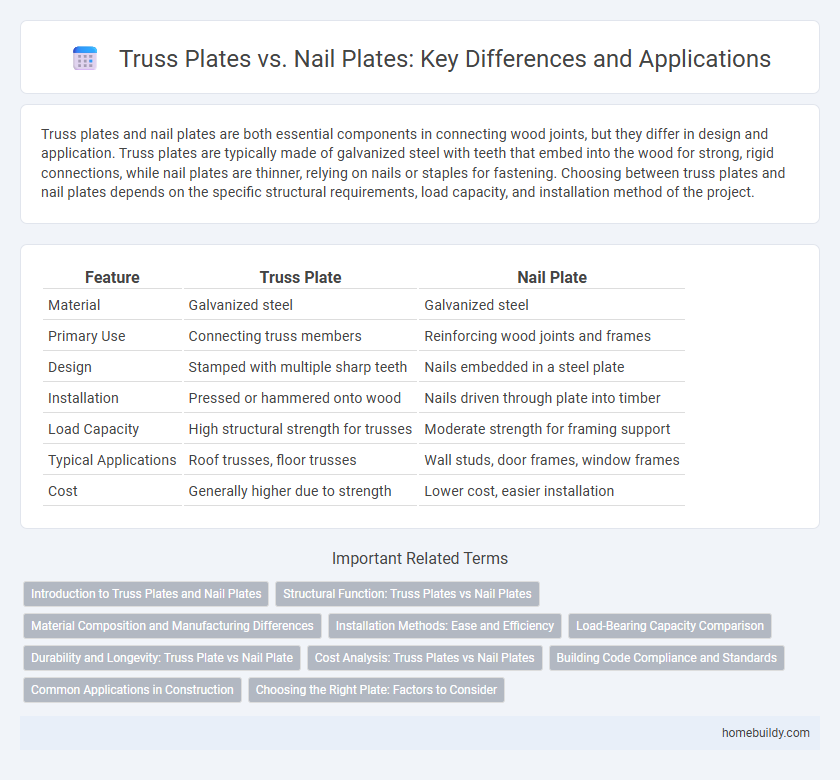Truss plates and nail plates are both essential components in connecting wood joints, but they differ in design and application. Truss plates are typically made of galvanized steel with teeth that embed into the wood for strong, rigid connections, while nail plates are thinner, relying on nails or staples for fastening. Choosing between truss plates and nail plates depends on the specific structural requirements, load capacity, and installation method of the project.
Table of Comparison
| Feature | Truss Plate | Nail Plate |
|---|---|---|
| Material | Galvanized steel | Galvanized steel |
| Primary Use | Connecting truss members | Reinforcing wood joints and frames |
| Design | Stamped with multiple sharp teeth | Nails embedded in a steel plate |
| Installation | Pressed or hammered onto wood | Nails driven through plate into timber |
| Load Capacity | High structural strength for trusses | Moderate strength for framing support |
| Typical Applications | Roof trusses, floor trusses | Wall studs, door frames, window frames |
| Cost | Generally higher due to strength | Lower cost, easier installation |
Introduction to Truss Plates and Nail Plates
Truss plates are metal connectors designed to join wooden structural elements, providing enhanced stability and load distribution in truss systems. Nail plates serve a similar purpose but are typically thinner and affixed using nails rather than being embedded into the wood, making truss plates more suitable for high-stress applications. Both components play critical roles in modern construction by ensuring secure and durable connections within roofing and framing assemblies.
Structural Function: Truss Plates vs Nail Plates
Truss plates provide superior structural integrity by creating strong, rigid connections through their embedded steel teeth, which distribute loads evenly across joints in wooden frameworks. Nail plates, although easier to install, primarily offer limited shear resistance and are prone to faster deterioration under heavy structural stress. The precision and strength of truss plates make them the preferred choice for high-load applications in modern timber construction.
Material Composition and Manufacturing Differences
Truss plates are typically made from galvanized steel with punched teeth designed for embedding into timber, ensuring a strong mechanical bond, whereas nail plates feature a simpler design with larger, fewer nails or spikes driven into wood connections. The manufacturing of truss plates involves precision stamping and galvanization to enhance corrosion resistance and structural integrity, while nail plates are often produced through basic metal cutting and bending processes. These material composition and manufacturing distinctions make truss plates more reliable for load-bearing applications in wooden truss construction.
Installation Methods: Ease and Efficiency
Truss plates offer a more efficient installation process compared to nail plates due to their pre-punched design, allowing for quick alignment and secure fastening with a hydraulic press or hammer. Nail plates require manual nailing or stapling, which is more time-consuming and labor-intensive, increasing the risk of misalignment. The ease of installation with truss plates leads to improved productivity while maintaining structural integrity in timber framing.
Load-Bearing Capacity Comparison
Truss plates exhibit significantly higher load-bearing capacity compared to nail plates due to their steel composition and precise mechanical interlocking with wooden members. The triangular teeth on truss plates distribute forces evenly across the joint, enhancing structural integrity under heavy loads. Nail plates, relying on simple nail penetration, often provide less rigidity and lower resistance to shear and tensile stresses in critical load-bearing applications.
Durability and Longevity: Truss Plate vs Nail Plate
Truss plates are made of galvanized steel with teeth designed to embed firmly into wood, providing enhanced durability and resistance to corrosion, which contributes to longer structural longevity. Nail plates typically use thinner metal with simple nail holes, offering less strength and a higher susceptibility to bending or rust over time. Consequently, truss plates ensure more reliable and enduring connections in heavy-load applications compared to nail plates.
Cost Analysis: Truss Plates vs Nail Plates
Truss plates typically offer a lower overall cost due to their faster installation process and reduced labor requirements compared to nail plates. Although nail plates may have a slightly lower material cost, the increased time and effort needed for secure fastening often result in higher total expenses. Evaluating both upfront material prices and long-term labor costs is crucial for an accurate cost analysis between truss plates and nail plates.
Building Code Compliance and Standards
Truss plates and nail plates both serve critical roles in structural framing but must meet specific building code compliance and standards. Truss plates are typically manufactured to conform with ASTM A653 standards for galvanized steel and are often required to comply with design specifications outlined in the International Building Code (IBC) to ensure load-bearing capacity and safety. Nail plates, while generally used for lighter fastening applications, must also adhere to local building codes and ASTM D2559 standards to maintain structural integrity in framing connections.
Common Applications in Construction
Truss plates are primarily used in the fabrication of pre-engineered wooden roof trusses, offering strong, durable connections that distribute loads efficiently across the truss framework. Nail plates, while similar in function, are often applied in lighter framing tasks and repairs where ease of installation and flexibility are prioritized. In construction, truss plates are favored for large-scale residential and commercial roofing systems due to their high strength and consistent performance under heavy loads.
Choosing the Right Plate: Factors to Consider
When choosing between a truss plate and a nail plate, consider load capacity, installation method, and material compatibility. Truss plates provide superior structural strength due to their galvanized steel construction with stamped teeth, ensuring a secure connection in high-stress applications. Nail plates, although easier to install with nails or staples, are best suited for lighter loads and temporary repairs, making truss plates the preferred choice for long-term, load-bearing truss systems.
Truss plate vs Nail plate Infographic

 homebuildy.com
homebuildy.com